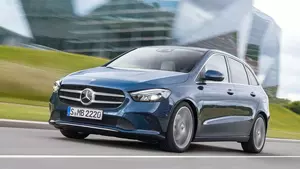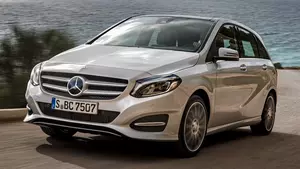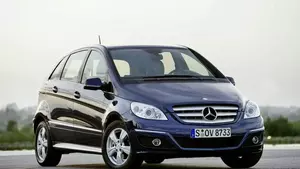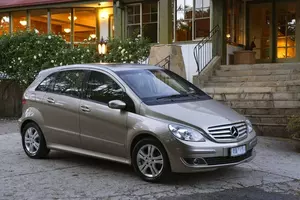
| Vehicle | Precise engine size | Difference from world average | Engine size to consumption ratio | Horsepower from 1 L | Engine size to 100 kg of weight |
|---|---|---|---|---|---|
| B 200d |
1.95 L (1950 cc) |
16.9% smaller | 35 cc to 1 mpg | 77 hp from 1 L | 130 cc to 100 kg |
| B 220d |
1.95 L (1950 cc) |
16.9% smaller | 37 cc to 1 mpg | 97 hp from 1 L | 130 cc to 100 kg |
| B 180 |
1.33 L (1332 cc) |
43.2% smaller | 32 cc to 1 mpg | 102 hp from 1 L | 102 cc to 100 kg |
| B 200 |
1.33 L (1332 cc) |
43.2% smaller | 33 cc to 1 mpg | 123 hp from 1 L | 102 cc to 100 kg |
| B 180d |
1.46 L (1461 cc) |
37.7% smaller | 24 cc to 1 mpg | 79 hp from 1 L | 97 cc to 100 kg |
| B 250 |
1.99 L (1991 cc) |
15.1% smaller | 54 cc to 1 mpg | 113 hp from 1 L | 142 cc to 100 kg |
| B 220 |
1.99 L (1991 cc) |
15.1% smaller | 52 cc to 1 mpg | 95 hp from 1 L | 142 cc to 100 kg |
| B 160 |
1.33 L (1332 cc) |
43.2% smaller | 32 cc to 1 mpg | 82 hp from 1 L | 102 cc to 100 kg |
| Vehicle | B 200d |
|---|---|
| Precise engine size | 1.95 L (1950 cc) |
| Difference from world average | 16.9 smaller |
| Engine size to consumption ratio | 35 cc to 1 mpg |
| Horsepower from 1 L | 77 hp from 1 L |
| Engine size to 100 kg of weight | 130 cc to 100 kg |
| Vehicle | B 220d |
| Precise engine size | 1.95 L (1950 cc) |
| Difference from world average | 16.9 smaller |
| Engine size to consumption ratio | 37 cc to 1 mpg |
| Horsepower from 1 L | 97 hp from 1 L |
| Engine size to 100 kg of weight | 130 cc to 100 kg |
| Vehicle | B 180 |
| Precise engine size | 1.33 L (1332 cc) |
| Difference from world average | 43.2 smaller |
| Engine size to consumption ratio | 32 cc to 1 mpg |
| Horsepower from 1 L | 102 hp from 1 L |
| Engine size to 100 kg of weight | 102 cc to 100 kg |
| Vehicle | B 200 |
| Precise engine size | 1.33 L (1332 cc) |
| Difference from world average | 43.2 smaller |
| Engine size to consumption ratio | 33 cc to 1 mpg |
| Horsepower from 1 L | 123 hp from 1 L |
| Engine size to 100 kg of weight | 102 cc to 100 kg |
| Vehicle | B 180d |
| Precise engine size | 1.46 L (1461 cc) |
| Difference from world average | 37.7 smaller |
| Engine size to consumption ratio | 24 cc to 1 mpg |
| Horsepower from 1 L | 79 hp from 1 L |
| Engine size to 100 kg of weight | 97 cc to 100 kg |
| Vehicle | B 250 |
| Precise engine size | 1.99 L (1991 cc) |
| Difference from world average | 15.1 smaller |
| Engine size to consumption ratio | 54 cc to 1 mpg |
| Horsepower from 1 L | 113 hp from 1 L |
| Engine size to 100 kg of weight | 142 cc to 100 kg |
| Vehicle | B 220 |
| Precise engine size | 1.99 L (1991 cc) |
| Difference from world average | 15.1 smaller |
| Engine size to consumption ratio | 52 cc to 1 mpg |
| Horsepower from 1 L | 95 hp from 1 L |
| Engine size to 100 kg of weight | 142 cc to 100 kg |
| Vehicle | B 160 |
| Precise engine size | 1.33 L (1332 cc) |
| Difference from world average | 43.2 smaller |
| Engine size to consumption ratio | 32 cc to 1 mpg |
| Horsepower from 1 L | 82 hp from 1 L |
| Engine size to 100 kg of weight | 102 cc to 100 kg |

| Vehicle | Precise engine size | Difference from world average | Engine size to consumption ratio | Horsepower from 1 L | Engine size to 100 kg of weight |
|---|---|---|---|---|---|
| B 160 CDI |
1.46 L (1461 cc) |
37.7% smaller | 26 cc to 1 mpg | 62 hp from 1 L | 97 cc to 100 kg |
| B 180 CDI |
1.46 L (1461 cc) |
37.7% smaller | 22 cc to 1 mpg | 75 hp from 1 L | 104 cc to 100 kg |
| B 200 CDI |
2.14 L (2143 cc) |
8.7% smaller | 46 cc to 1 mpg | 64 hp from 1 L | 134 cc to 100 kg |
| B 180 |
1.6 L (1595 cc) |
32% smaller | 37 cc to 1 mpg | 76 hp from 1 L | 114 cc to 100 kg |
| B 220 CDI |
2.14 L (2143 cc) |
8.7% smaller | 46 cc to 1 mpg | 83 hp from 1 L | 134 cc to 100 kg |
| B 200 |
1.99 L (1991 cc) |
15.1% smaller | - | 78 hp from 1 L | 133 cc to 100 kg |
| B 250 |
1.99 L (1991 cc) |
15.1% smaller | 57 cc to 1 mpg | 106 hp from 1 L | 133 cc to 100 kg |
| B 220 |
1.99 L (1991 cc) |
15.1% smaller | 57 cc to 1 mpg | 92 hp from 1 L | 133 cc to 100 kg |
| B 160 |
1.6 L (1595 cc) |
32% smaller | 37 cc to 1 mpg | 64 hp from 1 L | 123 cc to 100 kg |
| Vehicle | B 160 CDI |
|---|---|
| Precise engine size | 1.46 L (1461 cc) |
| Difference from world average | 37.7 smaller |
| Engine size to consumption ratio | 26 cc to 1 mpg |
| Horsepower from 1 L | 62 hp from 1 L |
| Engine size to 100 kg of weight | 97 cc to 100 kg |
| Vehicle | B 180 CDI |
| Precise engine size | 1.46 L (1461 cc) |
| Difference from world average | 37.7 smaller |
| Engine size to consumption ratio | 22 cc to 1 mpg |
| Horsepower from 1 L | 75 hp from 1 L |
| Engine size to 100 kg of weight | 104 cc to 100 kg |
| Vehicle | B 200 CDI |
| Precise engine size | 2.14 L (2143 cc) |
| Difference from world average | 8.7 smaller |
| Engine size to consumption ratio | 46 cc to 1 mpg |
| Horsepower from 1 L | 64 hp from 1 L |
| Engine size to 100 kg of weight | 134 cc to 100 kg |
| Vehicle | B 180 |
| Precise engine size | 1.6 L (1595 cc) |
| Difference from world average | 32 smaller |
| Engine size to consumption ratio | 37 cc to 1 mpg |
| Horsepower from 1 L | 76 hp from 1 L |
| Engine size to 100 kg of weight | 114 cc to 100 kg |
| Vehicle | B 220 CDI |
| Precise engine size | 2.14 L (2143 cc) |
| Difference from world average | 8.7 smaller |
| Engine size to consumption ratio | 46 cc to 1 mpg |
| Horsepower from 1 L | 83 hp from 1 L |
| Engine size to 100 kg of weight | 134 cc to 100 kg |
| Vehicle | B 200 |
| Precise engine size | 1.99 L (1991 cc) |
| Difference from world average | 15.1 smaller |
| Engine size to consumption ratio | - |
| Horsepower from 1 L | 78 hp from 1 L |
| Engine size to 100 kg of weight | 133 cc to 100 kg |
| Vehicle | B 250 |
| Precise engine size | 1.99 L (1991 cc) |
| Difference from world average | 15.1 smaller |
| Engine size to consumption ratio | 57 cc to 1 mpg |
| Horsepower from 1 L | 106 hp from 1 L |
| Engine size to 100 kg of weight | 133 cc to 100 kg |
| Vehicle | B 220 |
| Precise engine size | 1.99 L (1991 cc) |
| Difference from world average | 15.1 smaller |
| Engine size to consumption ratio | 57 cc to 1 mpg |
| Horsepower from 1 L | 92 hp from 1 L |
| Engine size to 100 kg of weight | 133 cc to 100 kg |
| Vehicle | B 160 |
| Precise engine size | 1.6 L (1595 cc) |
| Difference from world average | 32 smaller |
| Engine size to consumption ratio | 37 cc to 1 mpg |
| Horsepower from 1 L | 64 hp from 1 L |
| Engine size to 100 kg of weight | 123 cc to 100 kg |

| Vehicle | Precise engine size | Difference from world average | Engine size to consumption ratio | Horsepower from 1 L | Engine size to 100 kg of weight |
|---|---|---|---|---|---|
| B 180 |
1.6 L (1595 cc) |
32% smaller | 40 cc to 1 mpg | 76 hp from 1 L | 114 cc to 100 kg |
| B 180 CDI |
1.46 L (1461 cc) |
37.7% smaller | 28 cc to 1 mpg | 75 hp from 1 L | 97 cc to 100 kg |
| B 200 CDI |
1.8 L (1796 cc) |
23.4% smaller | 35 cc to 1 mpg | 76 hp from 1 L | 120 cc to 100 kg |
| B 200 |
1.6 L (1595 cc) |
32% smaller | 40 cc to 1 mpg | 98 hp from 1 L | 114 cc to 100 kg |
| B 160 CDI |
1.46 L (1461 cc) |
37.7% smaller | 28 cc to 1 mpg | 62 hp from 1 L | 97 cc to 100 kg |
| B 180 1.8 CDI |
1.8 L (1796 cc) |
23.4% smaller | 35 cc to 1 mpg | 61 hp from 1 L | 120 cc to 100 kg |
| B 220 CDI |
2.14 L (2143 cc) |
8.7% smaller | 42 cc to 1 mpg | 79 hp from 1 L | 143 cc to 100 kg |
| B 250 |
1.99 L (1991 cc) |
15.1% smaller | 51 cc to 1 mpg | 106 hp from 1 L | 133 cc to 100 kg |
| B 220 |
1.99 L (1991 cc) |
15.1% smaller | 57 cc to 1 mpg | 92 hp from 1 L | 133 cc to 100 kg |
| Vehicle | B 180 |
|---|---|
| Precise engine size | 1.6 L (1595 cc) |
| Difference from world average | 32 smaller |
| Engine size to consumption ratio | 40 cc to 1 mpg |
| Horsepower from 1 L | 76 hp from 1 L |
| Engine size to 100 kg of weight | 114 cc to 100 kg |
| Vehicle | B 180 CDI |
| Precise engine size | 1.46 L (1461 cc) |
| Difference from world average | 37.7 smaller |
| Engine size to consumption ratio | 28 cc to 1 mpg |
| Horsepower from 1 L | 75 hp from 1 L |
| Engine size to 100 kg of weight | 97 cc to 100 kg |
| Vehicle | B 200 CDI |
| Precise engine size | 1.8 L (1796 cc) |
| Difference from world average | 23.4 smaller |
| Engine size to consumption ratio | 35 cc to 1 mpg |
| Horsepower from 1 L | 76 hp from 1 L |
| Engine size to 100 kg of weight | 120 cc to 100 kg |
| Vehicle | B 200 |
| Precise engine size | 1.6 L (1595 cc) |
| Difference from world average | 32 smaller |
| Engine size to consumption ratio | 40 cc to 1 mpg |
| Horsepower from 1 L | 98 hp from 1 L |
| Engine size to 100 kg of weight | 114 cc to 100 kg |
| Vehicle | B 160 CDI |
| Precise engine size | 1.46 L (1461 cc) |
| Difference from world average | 37.7 smaller |
| Engine size to consumption ratio | 28 cc to 1 mpg |
| Horsepower from 1 L | 62 hp from 1 L |
| Engine size to 100 kg of weight | 97 cc to 100 kg |
| Vehicle | B 180 1.8 CDI |
| Precise engine size | 1.8 L (1796 cc) |
| Difference from world average | 23.4 smaller |
| Engine size to consumption ratio | 35 cc to 1 mpg |
| Horsepower from 1 L | 61 hp from 1 L |
| Engine size to 100 kg of weight | 120 cc to 100 kg |
| Vehicle | B 220 CDI |
| Precise engine size | 2.14 L (2143 cc) |
| Difference from world average | 8.7 smaller |
| Engine size to consumption ratio | 42 cc to 1 mpg |
| Horsepower from 1 L | 79 hp from 1 L |
| Engine size to 100 kg of weight | 143 cc to 100 kg |
| Vehicle | B 250 |
| Precise engine size | 1.99 L (1991 cc) |
| Difference from world average | 15.1 smaller |
| Engine size to consumption ratio | 51 cc to 1 mpg |
| Horsepower from 1 L | 106 hp from 1 L |
| Engine size to 100 kg of weight | 133 cc to 100 kg |
| Vehicle | B 220 |
| Precise engine size | 1.99 L (1991 cc) |
| Difference from world average | 15.1 smaller |
| Engine size to consumption ratio | 57 cc to 1 mpg |
| Horsepower from 1 L | 92 hp from 1 L |
| Engine size to 100 kg of weight | 133 cc to 100 kg |

| Vehicle | Precise engine size | Difference from world average | Engine size to consumption ratio | Horsepower from 1 L | Engine size to 100 kg of weight |
|---|---|---|---|---|---|
| B 150 |
1.5 L (1498 cc) |
36.1% smaller | 44 cc to 1 mpg | 63 hp from 1 L | 115 cc to 100 kg |
| B 170 |
1.7 L (1699 cc) |
27.6% smaller | 51 cc to 1 mpg | 68 hp from 1 L | 131 cc to 100 kg |
| B 180 CDI |
1.99 L (1991 cc) |
15.1% smaller | - | 55 hp from 1 L | 142 cc to 100 kg |
| B 200 |
2.03 L (2034 cc) |
13.3% smaller | - | 67 hp from 1 L | 156 cc to 100 kg |
| B 200 CDI |
1.99 L (1991 cc) |
15.1% smaller | - | 70 hp from 1 L | 142 cc to 100 kg |
| B 200 Turbo |
2.03 L (2034 cc) |
13.3% smaller | - | 95 hp from 1 L | 145 cc to 100 kg |
| Vehicle | B 150 |
|---|---|
| Precise engine size | 1.5 L (1498 cc) |
| Difference from world average | 36.1 smaller |
| Engine size to consumption ratio | 44 cc to 1 mpg |
| Horsepower from 1 L | 63 hp from 1 L |
| Engine size to 100 kg of weight | 115 cc to 100 kg |
| Vehicle | B 170 |
| Precise engine size | 1.7 L (1699 cc) |
| Difference from world average | 27.6 smaller |
| Engine size to consumption ratio | 51 cc to 1 mpg |
| Horsepower from 1 L | 68 hp from 1 L |
| Engine size to 100 kg of weight | 131 cc to 100 kg |
| Vehicle | B 180 CDI |
| Precise engine size | 1.99 L (1991 cc) |
| Difference from world average | 15.1 smaller |
| Engine size to consumption ratio | - |
| Horsepower from 1 L | 55 hp from 1 L |
| Engine size to 100 kg of weight | 142 cc to 100 kg |
| Vehicle | B 200 |
| Precise engine size | 2.03 L (2034 cc) |
| Difference from world average | 13.3 smaller |
| Engine size to consumption ratio | - |
| Horsepower from 1 L | 67 hp from 1 L |
| Engine size to 100 kg of weight | 156 cc to 100 kg |
| Vehicle | B 200 CDI |
| Precise engine size | 1.99 L (1991 cc) |
| Difference from world average | 15.1 smaller |
| Engine size to consumption ratio | - |
| Horsepower from 1 L | 70 hp from 1 L |
| Engine size to 100 kg of weight | 142 cc to 100 kg |
| Vehicle | B 200 Turbo |
| Precise engine size | 2.03 L (2034 cc) |
| Difference from world average | 13.3 smaller |
| Engine size to consumption ratio | - |
| Horsepower from 1 L | 95 hp from 1 L |
| Engine size to 100 kg of weight | 145 cc to 100 kg |

| Vehicle | Precise engine size | Difference from world average | Engine size to consumption ratio | Horsepower from 1 L | Engine size to 100 kg of weight |
|---|---|---|---|---|---|
| B 150 |
1.5 L (1498 cc) |
36.1% smaller | 44 cc to 1 mpg | 63 hp from 1 L | 115 cc to 100 kg |
| B 170 |
1.7 L (1699 cc) |
27.6% smaller | 51 cc to 1 mpg | 68 hp from 1 L | 131 cc to 100 kg |
| B 180 CDI |
1.99 L (1991 cc) |
15.1% smaller | - | 55 hp from 1 L | 142 cc to 100 kg |
| B 200 |
2.03 L (2034 cc) |
13.3% smaller | - | 67 hp from 1 L | 156 cc to 100 kg |
| B 200 CDI |
1.99 L (1991 cc) |
15.1% smaller | - | 70 hp from 1 L | 142 cc to 100 kg |
| B 200 Turbo |
2.03 L (2034 cc) |
13.3% smaller | - | 95 hp from 1 L | 145 cc to 100 kg |
| Vehicle | B 150 |
|---|---|
| Precise engine size | 1.5 L (1498 cc) |
| Difference from world average | 36.1 smaller |
| Engine size to consumption ratio | 44 cc to 1 mpg |
| Horsepower from 1 L | 63 hp from 1 L |
| Engine size to 100 kg of weight | 115 cc to 100 kg |
| Vehicle | B 170 |
| Precise engine size | 1.7 L (1699 cc) |
| Difference from world average | 27.6 smaller |
| Engine size to consumption ratio | 51 cc to 1 mpg |
| Horsepower from 1 L | 68 hp from 1 L |
| Engine size to 100 kg of weight | 131 cc to 100 kg |
| Vehicle | B 180 CDI |
| Precise engine size | 1.99 L (1991 cc) |
| Difference from world average | 15.1 smaller |
| Engine size to consumption ratio | - |
| Horsepower from 1 L | 55 hp from 1 L |
| Engine size to 100 kg of weight | 142 cc to 100 kg |
| Vehicle | B 200 |
| Precise engine size | 2.03 L (2034 cc) |
| Difference from world average | 13.3 smaller |
| Engine size to consumption ratio | - |
| Horsepower from 1 L | 67 hp from 1 L |
| Engine size to 100 kg of weight | 156 cc to 100 kg |
| Vehicle | B 200 CDI |
| Precise engine size | 1.99 L (1991 cc) |
| Difference from world average | 15.1 smaller |
| Engine size to consumption ratio | - |
| Horsepower from 1 L | 70 hp from 1 L |
| Engine size to 100 kg of weight | 142 cc to 100 kg |
| Vehicle | B 200 Turbo |
| Precise engine size | 2.03 L (2034 cc) |
| Difference from world average | 13.3 smaller |
| Engine size to consumption ratio | - |
| Horsepower from 1 L | 95 hp from 1 L |
| Engine size to 100 kg of weight | 145 cc to 100 kg |